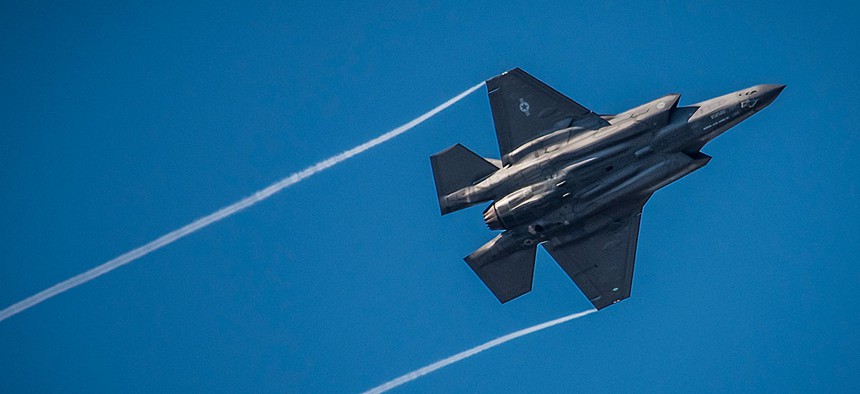Newly Revealed Experiment Shows How F-35 Could Help Intercept ICBMs
In 2014, the sensor-studded plane demonstrated an ability to track missiles, leading to a “tactically significant” improvement in targeting.
Rep. Duncan Hunter, R-Calif., raised more than a few eyebrows (and drew a few rolled eyes) when he suggested in November that the F-35 Joint Strike Fighter could intercept North Korean missiles headed for the United States. Hunter cited analysis from Los Alamos National Labs and other sources, according to Inside Defense.
Turns out the F-35 may be an ICBM buster after all, or at least be helpful toward that end. On Tuesday, Northrop Grumman called a small group of journalists to its offices in Linthicum, Maryland, to show the results of a 2014 experiment conducted with the Missile Defense Agency, or MDA.
The U.S. has no foolproof way to down a North Korean ICBM. Physics says the best opportunity comes during “boost phase,” as the rocket is leaving the launch pad. But DPRK anti-aircraft defenses make it difficult for the U.S. to get a weapon close enough to do any good. That’s why the Pentagon is looking at elaborate, futuristic concepts like arming drones with missile-killing lasers.
But the F-35 is studded with sensors like no other aircraft, including the Distributed Aperture System, or DAS, a half-dozen 17-pound electro-optical and infrared sensors. These feed a helmet-mounted display that allows the pilot to effectively “see through the plane” and spot incoming aircraft and missiles.
In October 2014, Northrop and MDA launched FTX-20, an experiment to see, among other things, whether the DAS could track an enemy ICBM. They took data from the sensors, ran it through algorithms developed by Northrop and MDA’s Enterprise Sensor Lab, generated a 3D-moving picture of the missile’s trajectory, and conveyed it over the Link 16 tactical data exchange. This kind of targeting data can help cue the U.S. Navy’s anti-ballistic missile destroyers or short- and intermediate-range missile defenses like the Army’s Terminal High Altitude Area Defense, or THAAD, missile battery deployed in South Korea.
The F-35 sensors aren’t meant to replace the infrared satellites that detect launches, or the sea-based X-Band Radar that can feed targeting data about missile launches to destroyers. Rather, Northrop officials said, the DAS data would help the other missile-defense gear get a targeting track on a missile more quickly, improving the odds of nailing the shot.
“That information can go straight to the Patriot [missile system], THAAD, or anywhere else, who has communication with that platform,” John “Bama” Montgomery, a business development manager at Northrop’s ISR & Targeting Division, said on Tuesday. “You can give that information to a shooter. That shooter now has information to go and put his information in the right place. Thus the radar doesn’t have to search. It goes, ‘I know where it is; it’s right there.’”
The end result is a “tactically significant” improvement in targeting, Montgomery said. Just how significant? It took several years to figure that out, and that’s one reason why the news is only being released now. “We wanted to get our understanding of how this could change the battlefield. We’ve since done a series of modeling and [simulation] events and teamed with other governmental partners and industry.”
Those numbers, he said, are classified. But: “I can tell you right now that this system, as depicted here, really does help the ballistic missile environment.”




